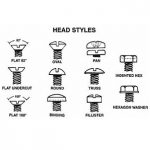Process of heat treatment.
Depending on the object and purpose, various heat treatment processes can be selected.
Tempering steel: tempering at high temperature after quenching (500-650℃).
Spring steel: tempering at medium temperature after quenching (420-520℃).
Carburized steel: quenching after carburizing and tempering at low temperature (150-250℃).
After quenching low and medium carbon steels (alloys) to martensite, the strength usually decreases with increasing tempering temperature, while the plasticity and toughness increase.
However, due to the different carbon content in low and medium carbon steels, the tempering temperature has different effects on these steels. Therefore, to obtain good comprehensive mechanical properties, you can take the following approaches:
(1) Select a low carbon (alloy) steel, and after quenching, perform low temperature tempering below 250 °C to obtain low carbon martensite. To improve the wear resistance of the surface of this steel, the only way to increase the carbon content of each surface layer is surface carburization, commonly called carburized structural steel.
(2) Take a steel with medium carbon content, and after quenching, carry out high temperature tempering (500-650 ℃) (called quenching and tempering treatment) to achieve sufficient strength with high plasticity, which is commonly called quenched and tempered steel. If you want to achieve high strength but prefer lower plasticity and toughness, you can choose the low-temperature tempering for the gold-bearing low-carbon tempering, and you will get the so-called “ultra-high strength steel”.
(3) Steels with carbon content between medium and high carbon (e.g. 60s, 70s steel) and some high carbon steels (e.g. 80s, 90s steel) are annealed at medium temperature after quenching in the production of springs to ensure high elasticity, yield strength and fatigue limit.
Working process
Steel tempering: annealed (pearlitic steel).
- preheating treatment: normalizing tempering at high temperature (martensitic steel). The purpose of normalizing is to refine the grains, reduce the degree of banding in the microstructure and adjust the hardness to facilitate machining. After normalizing, the steel has equiaxed fine grains.
- quenching: heat the steel body to about 850°C for quenching. The quenching medium can be selected according to the size of the steel piece and the hardenability of the steel. Generally, water, oil or even air can be used for quenching. Steel in quenched condition has low plasticity and high internal stresses.
- tempering: To give the steel high plasticity, toughness and reasonable strength, the steel is tempered at a high temperature of about 400-500°C. Steels that are more sensitive to tempering brittleness must be cooled quickly after tempering to suppress tempering brittleness. Brittleness occurs.If the parts are to have particularly high strength, they should be tempered at about 200°C to obtain a tempered martensite structure with medium carbon content.
Spring steel:
- quenching: oil quenching at 830-870℃.
- tempering: Tempering is carried out at about 420-520 °C to obtain a hardened troostite structure.
Carburizing of steel:
- carburizing: A type of chemical heat treatment that refers to the penetration of the element carbon into the surface of steel parts in an active medium containing a specific chemical element at a specific temperature. Preheating (850℃) carburizing (890℃) diffusion process (840℃).
- Quenching: For carbon and low alloy carburized steel, direct quenching or one-time quenching is generally used.
- Tempering: Tempering at a low temperature to eliminate internal stress and improve the strength and toughness of the carburized layer. In our production, the tempering temperature of tapping screws is about 360℃, and the tempering temperature of self-drilling screws (wall panel screws) is about 200℃, and then cooled to 34-35℃ and 39-40℃ respectively.











